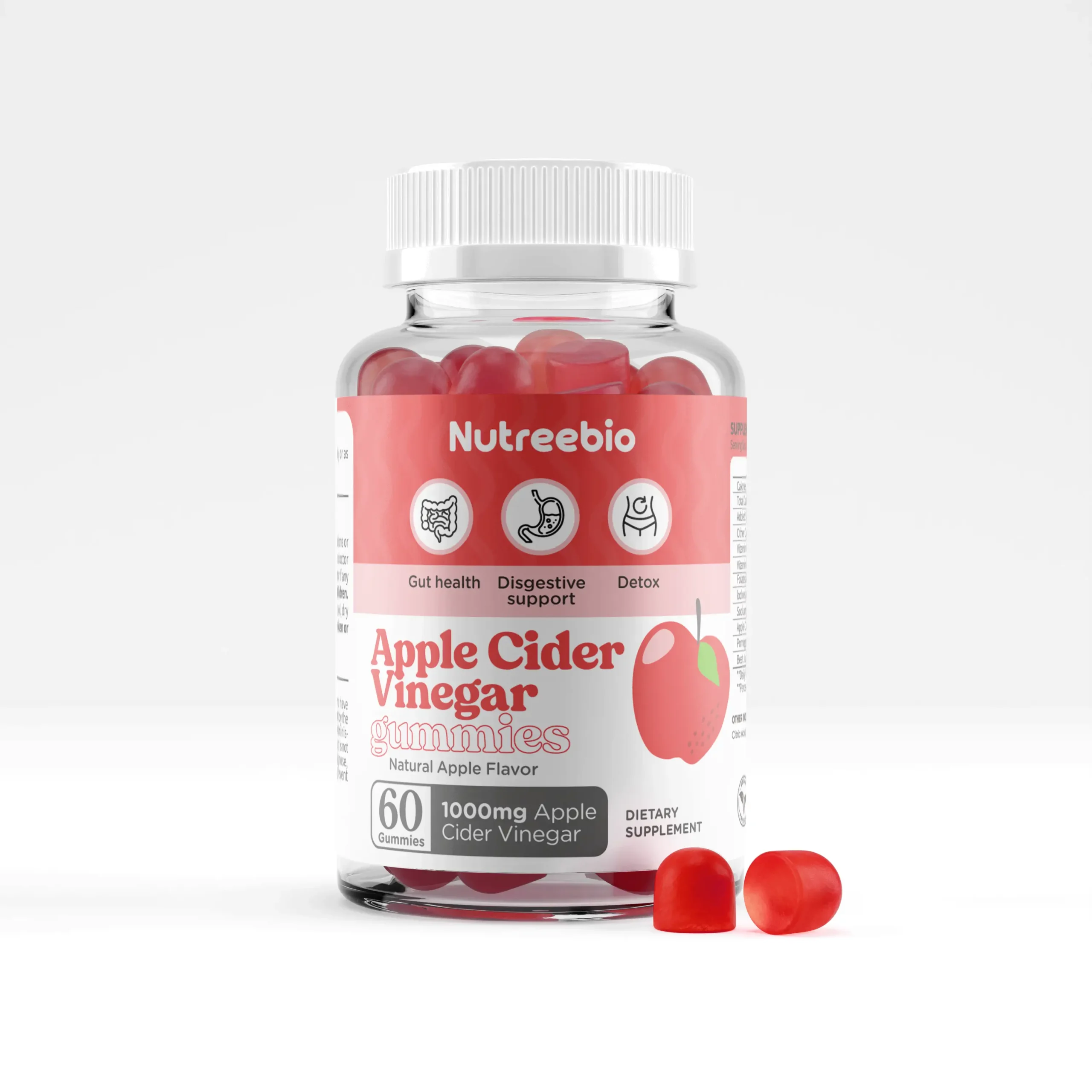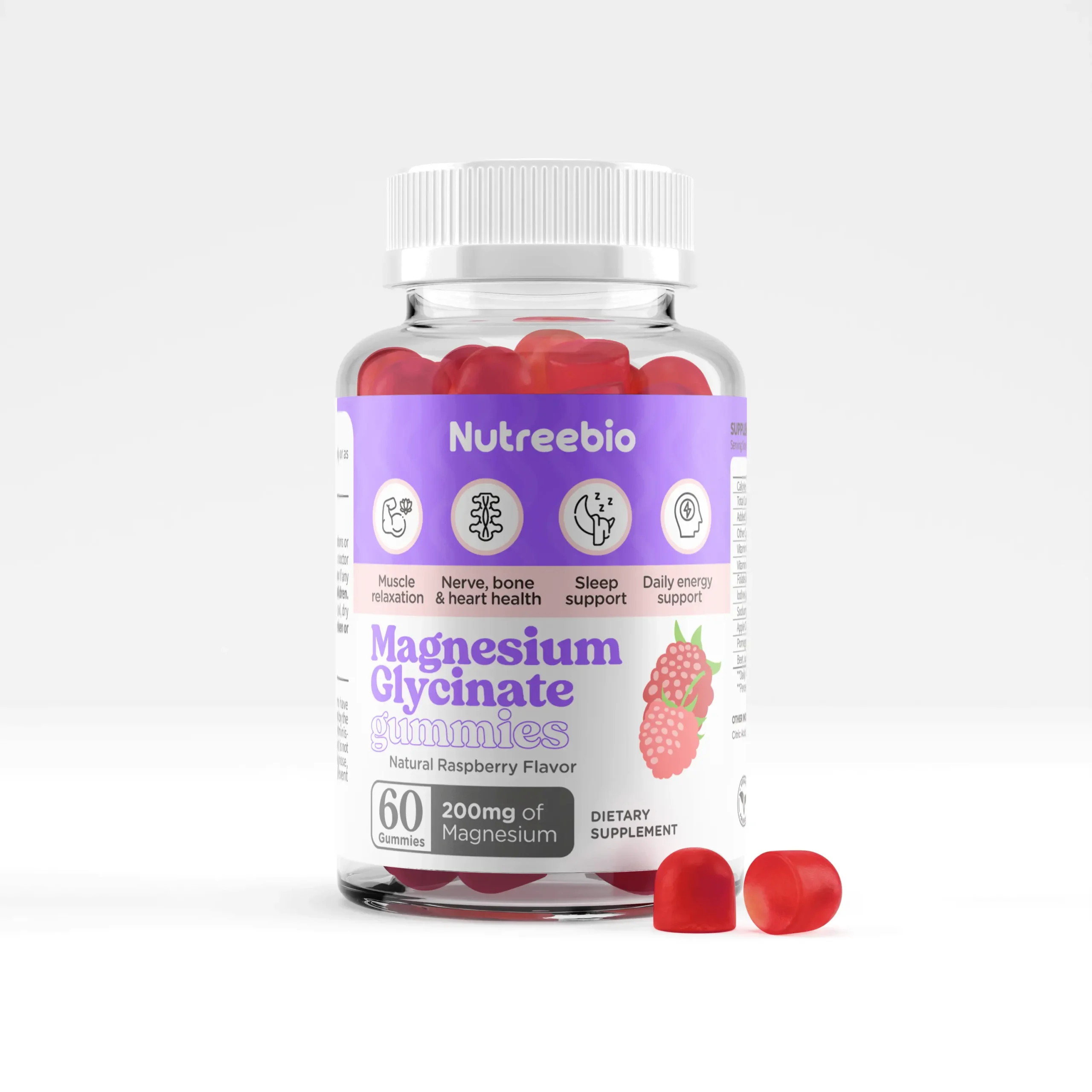According to data analysis from the World Bank, as of 2022, the global population aged 65 and above accounts for 9.7%[1], and with the acceleration of aging trends, it is predicted by the National Bureau of Statistics of China that by 2030, many countries will enter a super-aged society.
With the intensification of global aging, the elderly food market has gradually become a huge business opportunity. Japan, as the country with the most severe aging population globally, has rich experience in the development of elderly food, and its regulations and policies regarding elderly food are relatively sound. This article will delve into the elderly functional food market in Japan and explore its implications for the development of elderly food domestically.


1. Gap in the Aging Market
Currently, global aging is becoming increasingly severe, especially evident in developed countries. For example, the proportion of people aged 65 and above in the total population is 17.1% in the United States[2], and including Canada, the proportion of people aged 65 and above in the North American region is 17.3%[3]. The proportion of people aged 65 and above in EU member states has reached 21%, with Portugal, Italy, and Finland having the highest proportions, all at 37.8%[4]. In Asian developed countries, Japan's proportion of people aged 65 and above is 29.9%[5], and South Korea's proportion of people aged 65 and above this year is 17.5%, expected to reach 20% by 2025[6].
According to data analysis from the World Bank, as of 2022, China's proportion of the population aged 65 and above is 13.72%, and with the acceleration of aging trends, it is predicted by the National Bureau of Statistics that by 2030, the elderly population will reach 370 million, accounting for 25.5% of the total population, and China will enter a super-aged society.
Behind the aging society is a significant silver economy. The "Research on China's Aging Industry Development and Indicator System" report predicts that by 2030, the total consumption of the elderly population in China will reach 12 trillion yuan to 15.5 trillion yuan, and by 2050, it is estimated to reach 40 trillion yuan to 69 trillion yuan, with the proportion of the national GDP also increasing to 12.2% to 20.7%. This indicates that the aging industry, including elderly care services, medical care, elderly food, etc., will face enormous market demand.
Additionally, according to the "2019-2020 China Food Consumption Trends and Innovation White Paper," the average annual per capita consumption of elderly people in China is 15,560 yuan, with food consumption accounting for 39% of it. The elderly food market in China has tremendous potential.
However, currently, many food markets targeting the elderly are mainly concentrated in the health care field. Compared with segmented markets such as children's food and women's food, the product types are single, mainly focusing on "instant food" and far from satisfying the diverse needs of the elderly for nutrition, texture, and sensory experience. Therefore, it is necessary to further develop foods that meet the needs of the elderly to fill the market gap.
2. Insights from the Japanese Market on Food Development of Elderly Nutrition
Research indicates that the development of special foods mainly focuses on meeting nutritional needs and texture characteristics[7]. For the special group of elderly people, their food design should also follow this principle. From the perspective of the Japanese market, this point has been fully reflected and practiced.
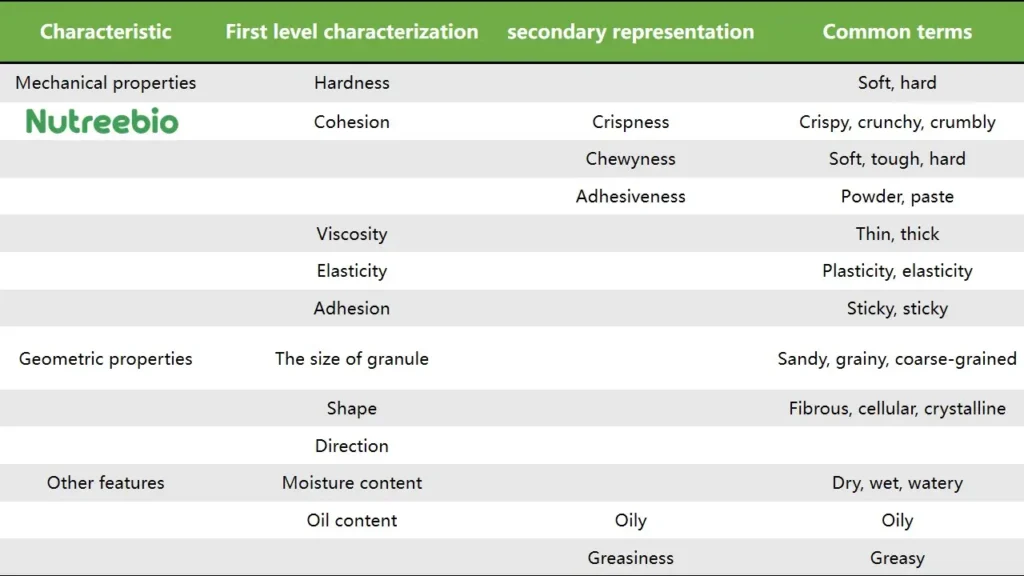

2.1 Japanese Nursing Foods
Elderly people generally face problems such as tooth loss, weakened biting force, reduced saliva secretion, insufficient oral muscle strength, and decreased coordination ability, resulting in decreased chewing ability and inability to chew regular food. Therefore, it is of great significance to adjust the texture characteristics of elderly food reasonably for the dietary safety of the elderly.
Szczesniak divides the texture characteristics of food into mechanical characteristics, geometric characteristics, and other characteristics[8]. Generally, the modifier terms for the texture attributes of special foods (including elderly food) mainly include hardness, viscosity, adhesion, and cohesiveness, etc., and the commonly used terms for the texture characteristics of special foods are mostly soft, pasty, and sticky.
In order to meet the special dietary needs of the elderly, the Japanese Ministry of Health, Labour and Welfare has formulated the "Health Promotion Law," which includes special dietary foods for the elderly, known as "nursing" foods or "smile-care foods." Starting from the texture of food, nursing foods are classified according to "hardness," "viscosity," and "swallowing ability," and different colors are used for labeling classification, making it easy for the elderly to choose and more intuitive and convenient for purchasing and using.
As of February 1, 2024, there are 51 companies in Japan that have obtained the Smile Care food identification logo usage permit, with a total of 224 products through the permit. According to research on the Japanese elderly food market by Fuji Economic Co., Ltd., in 2019, the Japanese elderly food market reached 169.1 billion yen, and it is expected to reach 204.6 billion yen by 2025. The demand for nursing foods in Japan continues to expand[9].
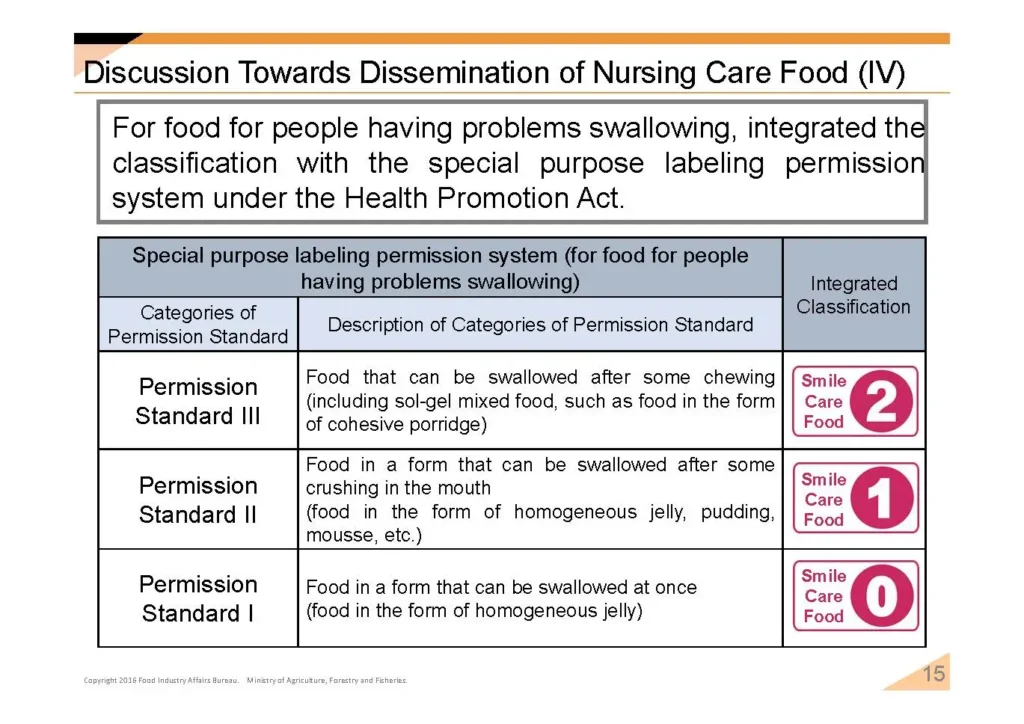

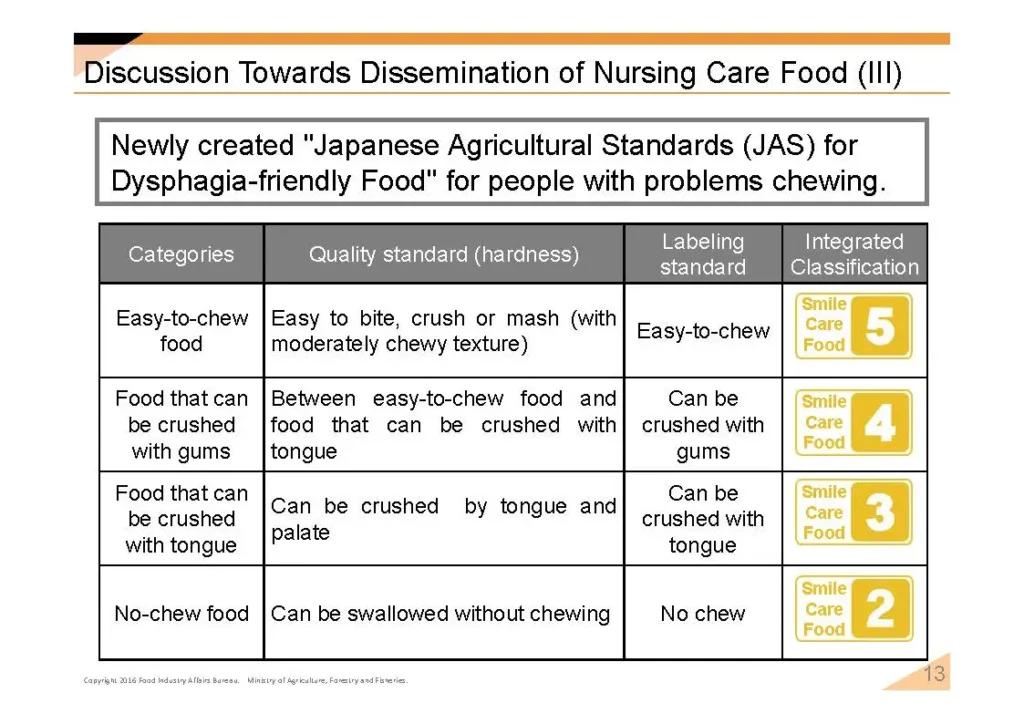

In China, in fact, in 2018, the National Health Commission issued China's first national standard for elderly food, the "National Standard for Food Safety for the Elderly Food (Draft for Solicitation of Comments)." According to the Chinese Dietary Guidelines for Residents, the current dietary of the elderly in China is mainly divided into three categories: soft food, semi-liquid food, and paste food. When developing and designing food for the elderly, several principles need to be followed:
- Adjust the hardness of solid food to adapt to the oral muscle and tongue muscle strength of the elderly for safe chewing.
- Increase the viscosity of liquid food to avoid choking caused by food flowing too fast.
- Reduce the application of fibrous products and increase the digestion speed of food in the oral cavity.
Compared with traditional tablets and capsules, nutritional gummies have become a more suitable food supplement for the elderly.
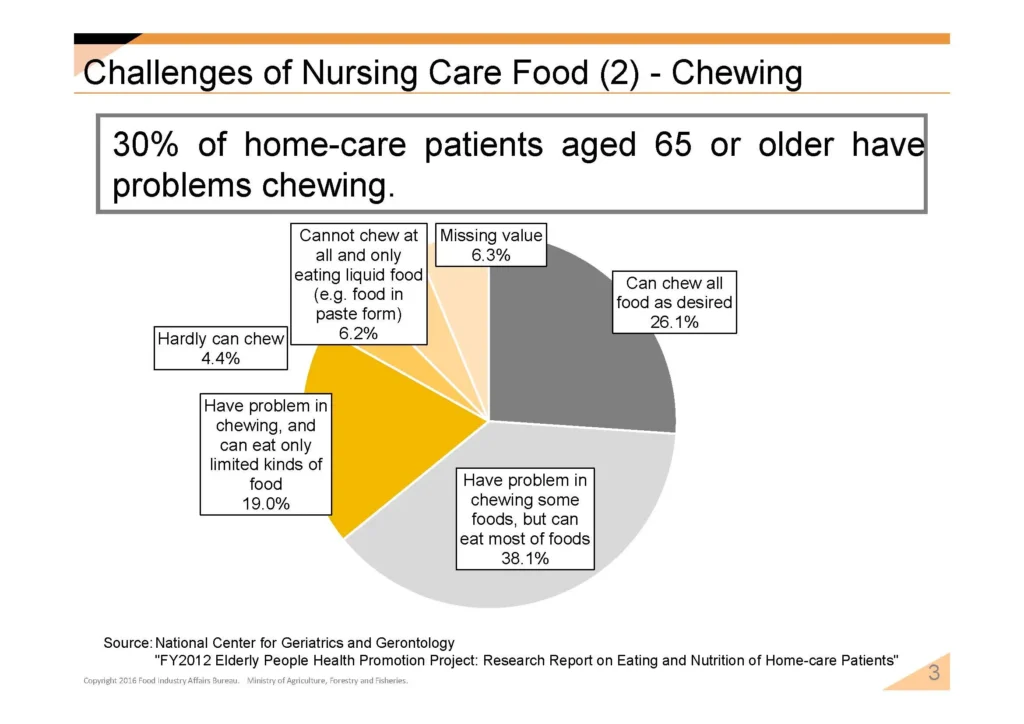

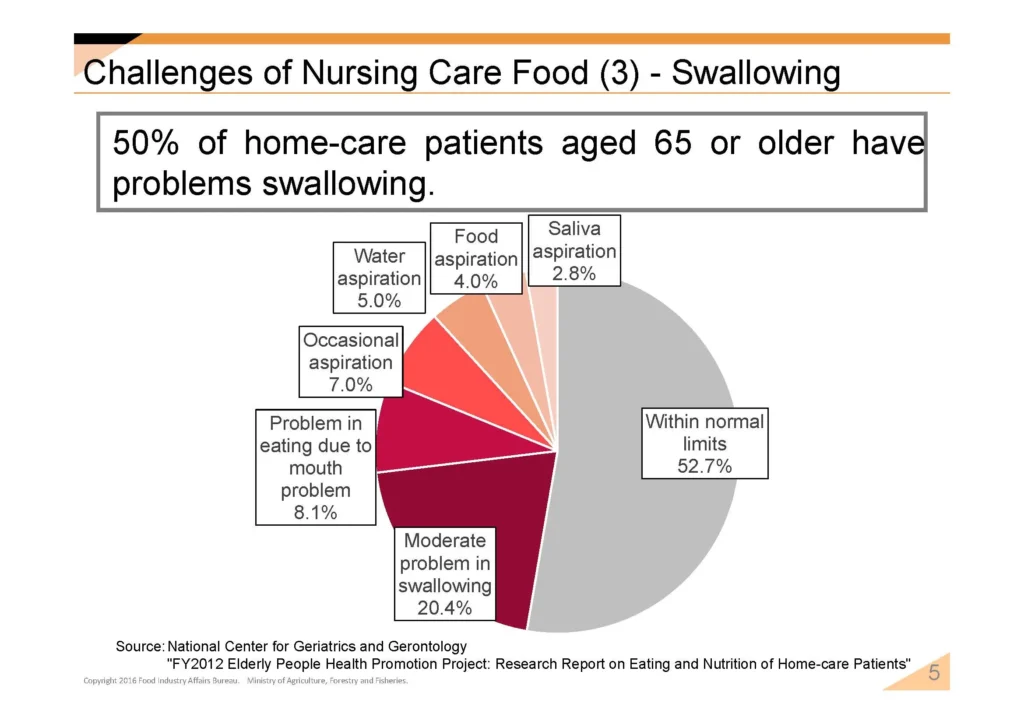

2.2 Needs of the Elderly Nutrition
Japan's health functional foods are mainly divided into three categories: specific health foods, functional labeling foods, and nutritional functional foods. Among them, the production enterprises of functional labeling foods need to provide scientific evidence of the functionality and safety of the food and apply for permission from relevant departments.
According to Japan's "2022 White Paper on Aging Society," the main reasons for the need for long-term care for people aged 65 and above are cognitive issues (18.1%) and cerebrovascular diseases (15%), followed by weakness caused by old age (13.3%), fractures/falls (13%), and joint diseases (11%). Therefore, functional labeling foods for the elderly in Japan mainly target three major health needs: improving cognitive function, reducing three highs, and maintaining bone and joint health.
2.2.1 Improving Cognitive Function
Cognitive impairment, medically known as cognitive dysfunction, refers to abnormal brain processes related to higher-level intellectual processing such as learning, memory, and thinking judgment, leading to severe learning and memory impairment, accompanied by changes in speech, use, recognition, or gait. According to data released by the Ministry of Health, Labour and Welfare, it is estimated that by 2025, the number of dementia patients in Japan will exceed 7 million.
A. Popular ingredients
DHA, EPA, β-casein, lion's mane mushroom, ergothioneine, lutein, zeaxanthin, flavonoids (Ginkgo biloba leaf), triterpenoids (Ginkgo biloba leaf), astaxanthin, phosphatidylserine (soybean), ginsenoside Rg1, Rb1, Rg3, aldehyde lecithin (chicken), humulene (aged hops), dipeptides, reduced coenzyme Q10, curcumin, Lactobacillus MCC1274, 7 essential amino acids [leucine, phenylalanine, lysine (hydrochloride), isoleucine, histidine (hydrochloride), valine, tryptophan], ginsenoside soapine, 6-methylsulfonyl hexyl isothiocyanate (mustard)
B. Product Application
Nutreebio has launched a blend of 5 mushroom gummies, a carefully crafted unique blend to support overall health, easy to chew, easy to digest, especially for our elderly customers. This supplement is rich in a powerful combination of five mushrooms (including lion's mane mushroom), each with various effects. Lion's mane mushroom is renowned for its cognitive enhancement properties and is a key ingredient in our blend. The formula, combined with other mushrooms such as reishi, chaga, cordyceps, and turkey tail, aims to support mental clarity, maintain memory, and focus attention, all of which are essential for the cognitive health of the elderly.
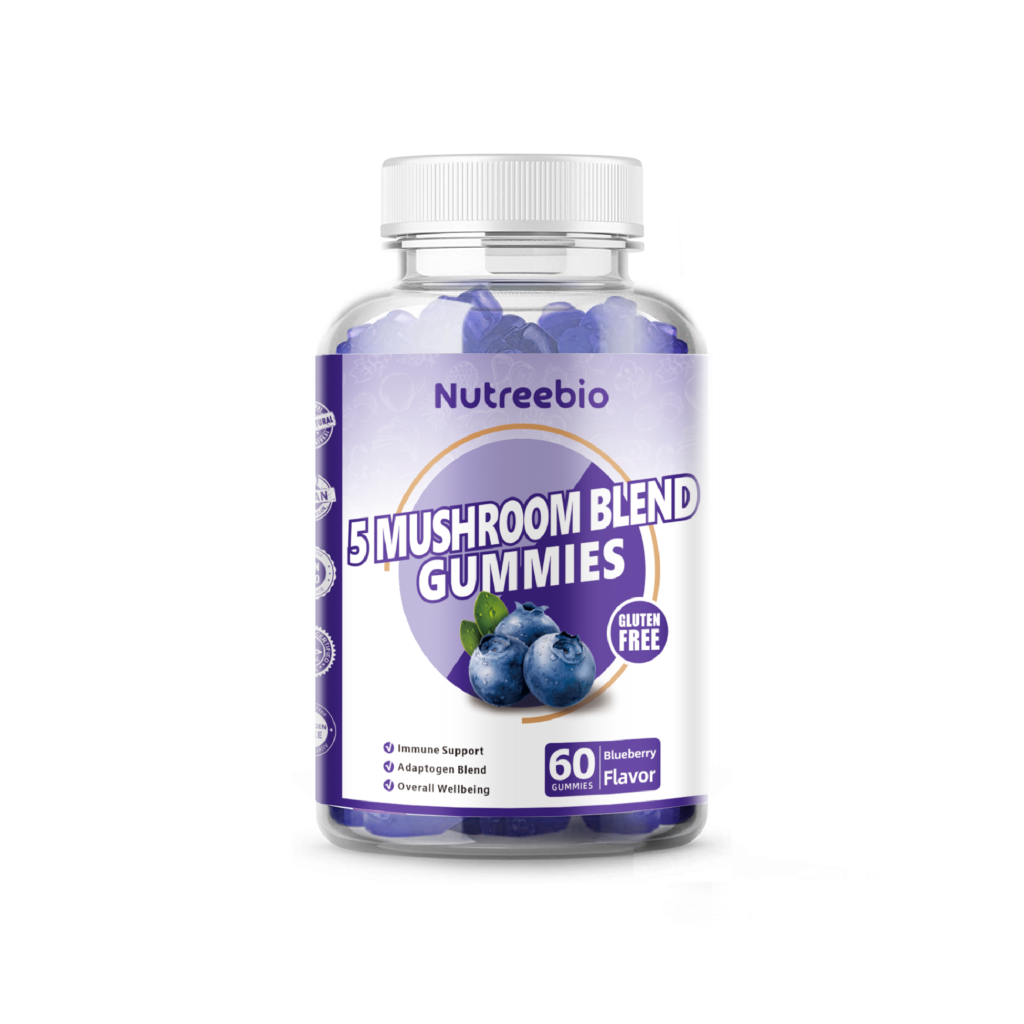

2.2.2 Reducing Three Highs
The three highs refer to hyperlipidemia, hypertension, and hyperglycemia, mainly due to the metabolic disorder of substances such as protein, fat, and carbohydrates in the human body, which are the three main risk factors for the onset and death of cardiovascular and cerebrovascular diseases. According to the "2022 Nutrition and Health Trend White Paper" by JD Health, the three highs are the most concerned health issues for the silver-haired population.
A. Popular ingredients
GABA, DHA, EPA, ACV, isomaltodextrin, chlorogenic acid, resistant maltodextrin, fructooligosaccharide, HMPA, β-glucan, 5-aminoethylphosphoric acid, proanthocyanidins, calcium alginate, water-soluble dietary fiber, EGCG, guar gum hydrolyzate, morphine, monoglucosyl rutin, gallic acid, alloxan, paeoniflorin, tea polyphenols, tannic acid, quercetin, tea saponin, monoglucosyl hesperidin, β-conglycinin, inulin, nattokinase, cocoa xanthine alcohol, monoglucosyl hesperidin, α-linolenic acid
B. Product Application
Apple cider vinegar gummies have always been a hot product for Nutreebio, especially suitable for the elderly aiming to control the three highs (hypertension, high cholesterol, and high blood sugar). Apple cider vinegar gummies are made from high-quality apple cider vinegar, fully utilizing the natural effects of apple cider vinegar, namely promoting heart health, regulating blood sugar levels, and improving blood lipids. The combination of the bioactive compounds in apple cider vinegar (including acetic acid and polyphenols) has potential benefits for lowering blood pressure and cholesterol levels and helping glucose metabolism. Our apple cider vinegar gummies are carefully crafted to provide a delicious alternative to liquid form apple cider vinegar, making it easier for the elderly to chew and carry, integrating these beneficial ingredients into their daily lives.
2.2.3 Bone and Joint Health
Research indicates that after the age of 30, the content of glucosamine in the human body decreases continuously and is no longer generated. After the age of 70, the glucosamine in the human body is almost depleted, leading to joint pain primarily due to the loss of glucosamine. The demand for bone and joint health in the Japanese functional food market mainly focuses on alleviating joint discomfort, increasing/maintaining bone density, and maintaining muscle strength/improving walking ability.
A. Key Ingredients
Alleviating Joint Discomfort: Elastic protein peptides (from skipjack tuna), protein polysaccharides (from salmon nasal cartilage), magnesium citrate, N-acetylglucosamine, non-denatured type II collagen (from salmon nasal cartilage), dipeptides, collagen peptides, glucosamine hydrochloride, non-denatured type II collagen, soy isoflavones, capsaicinoids (such as β-cryptoxanthin, β-carotene, zeaxanthin, capsanthin), chicken claw hydrolyzed peptides, AKBA (3-O-acetyl-11-keto-β-boswellic acid), hydroxytyrosol (from olives).
Maintaining Muscle Strength/Improving Walking Ability: Polymethoxy flavones (from black ginger), corosolic acid (from banana leaves), GABA, β-hydroxy-β-methylbutyrate calcium (HMB-Ca).
Increasing/Maintaining Bone Density: Calcium maltobionate, MBP (milk basic protein).
B. Product Application
Magnesium glycinate is a highly absorbable form of magnesium, with the ingredient magnesium citrate playing a crucial role in bone density and muscle function. By supplementing with magnesium glycinate, joint discomfort can be alleviated, and support for muscle strength and mobility can be provided. Nutreebio's magnesium glycinate gummies are carefully formulated by our product formulation experts to ensure optimal absorption and effectiveness. We also welcome custom ingredient requests from customers or discussions on formulation with our team.
References:
[1] Data source: World Bank. https://data.worldbank.org.cn/indicator/SP.POP.65UP.TO.ZS
[2] Data source: World Bank. https://data.worldbank.org.cn/indicator/SP.POP.65UP.TO?locations=US
[3] Data source: Huaon. https://www.huaon.com/channel/globaldata/943826.html
[4] Data source: Economic and Commercial Office of the Mission of the People's Republic of China to the European Union. http://eu.mofcom.gov.cn/article/jmxw/202305/20230503410227.shtml
[5] Data source: Huaon. https://www.huaon.com/channel/globaldata/943804.html
[6] Data source: Economic Daily News. https://zhuanlan.zhihu.com/p/678304391
[7] Chen, Jianshe. "Oral Physiology and Food Physics Basis of Special Food Texture Standards." Chinese Journal of Food Science, 2018, 18(003):1-7.
[8] SZCZESNIAK A S. Classification of textural characteristics[J]. Journal of Food Science, 2010, 28(4): 385-389.
[9] https://www.fuji-keizai.co.jp/press/detail.html?cid=20014

